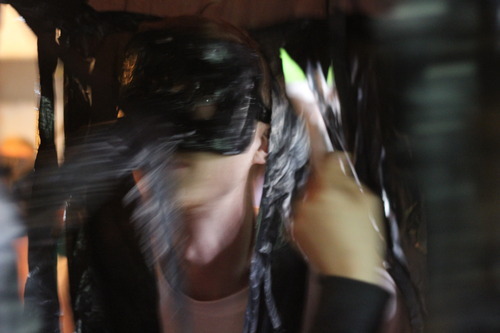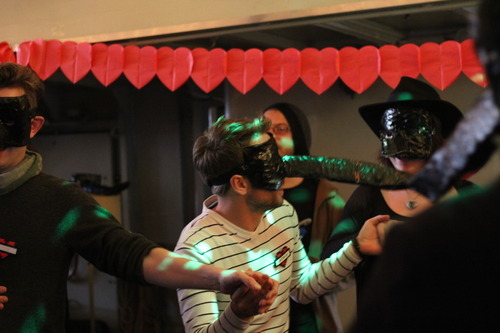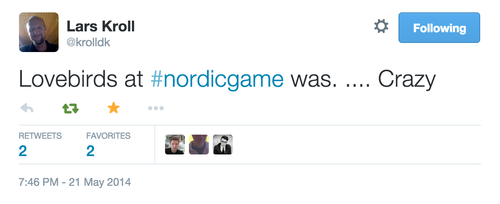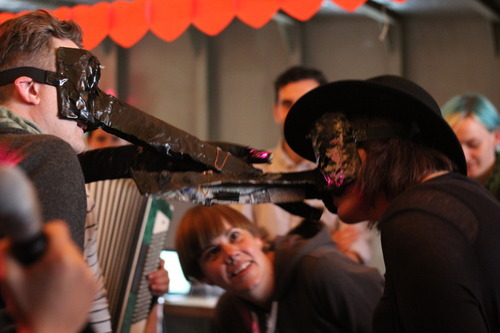Game Design: A Craft of Platform and Community Building
I intended to study a sound work for this probe, until after a second reading of Jonathan Sterne’s analysis of the mp3. The article inspired me to take a similar look at one of my own projects, Lovebirds, which I made together with 5 peers last winter. Following Sterne’s article I will reflect on how the technological platform of this project distributes a certain delegation of perception between humans and non-humans and as such how it affords certain social practices and communities. With these reflections I suggest a perspective on game design as a craft of simultaneously designing a technology and community, which, when coming together creates a platform for something we recognize as new, intriguing and (socially) interesting.
Lovebirds
Lovebirds is a game or an interactive performance, developed first as a stage performance and then evolved into a “9 player experience”. It has since then been shown at festivals of events. The piece is always evolving and is taking new forms for every time it is performed.

In the 9 player experience of Lovebirds there are 9 “beakers” each wearing a “beak” and on a quest to find -__.true love – or just have fun exploring the beaking activity (See some very raw footage here).
The instructions are broadcasted over microphone in a deep and sensual voice, maybe resembling the aesthetic of a sleazy love club experience. The music is a live jam of classical violin, female voice and which ever instruments and musicians there are around. The jam is freely improvising over how the event evolves. While the beaking is happening a spectator might comment on the event through another microphone. The commentator – for example playing the role of e.g. a TV host of a bird watching documentary, or a film director of an amateur style (porn) movie – is responsible to give performance has a classic dramatic arch.
The technical details of the beaks are broken circuits; a battery, an LED and three wires. On the outside they have a number of sensitive areas, that, when connected with other beaks, close the circuit and let the LEDs light up.
The LED is non-colour and only show its colour when beaking “right”. True love ones share the same coloured flashlight, so finding -__.true love involves exploring as many beaking partners as possibly.
Expert beakers, or those who feel inspired for some “advanced beaking”, can find inspiration cards with either a fetish or a fantasy. Such inspirations might be: “I only beak while being watched”, “I am attracted to non-beakers”, “I am attracted to other beaking couples”,“I like the feel of plastic on my beak”, “I like weeping while beaking”, “I like compliments on my beak while beaking“, “I’m a loud beaker”, “I always beak from the top”, etc.

The play ends with a prayer celebrating love and romance, and a ritual with song and dance in which everyone joins in – players, spectators and the live band. Yes, thats pretty silly and perhaps a little embarrassing.
A space of broken romance
The piece looks spectacular. The romantic music, the darkness right after sunset, the soothing and trustworthy voice of instructions, the beaks reminding us of Vencian upperclass mascarades, an anticipation of something wonderful, unusual and breathtaking.
And yet, the piece is broken on many levels. The beaks are home-made and actually not very comfortable to wear. Beaking is difficult; it is hard to light up the LEDs and the experience is far from as romantic and smooth as it looks.
The language and the grammar is incorrect – this increases throughout the piece – until the final love prayer, which does not have a single sensical or correct sentence (sound sample available here).

Murray and Wiercinski comments (2012) that the written word can be ambiguous and “that hearing something read aloud can reduce this ambiguity” because both speech sounds and absent of sounds “helps a listener to better understand its intellectual, emotional, and aesthetic meaning”.
Lovebirds has no intention of communicating a particular intellectual, emotional, aesthetic and unambiguous meaning. Lovebirds is “gloriously wanky”. By using the the elements of live voice, live music, mascarade, prayers etc, it pretends not just “normality” but extravagant high class culture – while the words spoken are not following conventional grammar or common sense logic (John Law 2003).
This is the space within the players are playing. Loaded with connotations of high culture and pretentiously sensical while players and spectators are actually left to themselves to make sense, and we enjoy their interpretations, confusion, associations and “misunderstandings”.
Delegations
By using the broken circuit, the Lovebirds is a single-bit technology, which brings Lovebirds in the category of digital games. For the sake of comparison let me compare Lovebirds the game Mario Bros (1983). Mario was developed for a range of 8-bit game consoles, e.g. Nintendo Entertainment System (NES).
The 8-bit processor, a board and a game cartridge of RAM (memory) and a 2 kB Picture Processor adds a complexity that is almost not possible to grasp. Just the 8-bit processor gives 256 possible states instead of the two (on/off) of the single-bit beaks.
The NES technology allows for multiple LEDs to light up in a pattern which we unambiguously can recognize as a world with a set of characters, Mario, Princess Peach, etc. While players of Lovebirds are left to make their best story of a flickering LED, the players of Mario Bros are looking at multiple LEDs that light up in a pattern which we unambiguously can recognize as a world with ground, clouds, coins and a set of characters.
Lovebirds’ single LED is all the beakers has to make meaning out of. This is the first delegation of interpretation and perception. Similarly to how the mp3, due to its minimalism, delegates aspects of the listening to the listening bodies, so does the simplicity of the beaks delegate tasks of the visual sense making to the players and the playing community.

In most digital games the characters and the world of Mario Bros has specific possible actions which are triggered by particular player inputs, e.g. the jump-button makes the Mario character jump and particular sounds are triggered by particular game events, e.g. Mario’s collision with a coin. These are the controlled mechanics that control progress and meaning. In Lovebirds no events has specific sounds attached to them. The band – a conjunction of game masters and participants – together interpret and assign sounds to these as they happen. This further means that while a technologically progress in a digital game like Mario Bros is not available for negotiation, the beaks flickering lights do not give conditions for the further play. Permission on progress is given by the game masters on site; did it flickr? did it flickr enough? did the players do enough of an effort? How much do we like them? What is our mood today? Would the game flow benefit if we let them pass although we didn’t really see any flickering? or would the game flow better if we give them an extra challenge by not approving the flickering we see?
That is a second level of interpretation delegated to the human actors (game masters) on site.
Playing as communal practice
Following Sterne’s analysis of how the mp3 has ideologies and qualities that supports and inscribe the social practices of file sharing, I will spend this section thinking about the community and social practices afforded by the beaks.
The beaks assumes the players to be highly engaged, responsible for their own experience and willing to take part in interpretation and sense-making of a highly ambiguous technology. This is on the level of story making and make belief; which world are we in? an innocent bird watching documentary or are we in a Love Club of bird fetishes? What does it mean to beak? is it a unique activity existing only within the game or do we assign authority to the various associations?
Another level of engagement and responsibility is on how the performance evolves. Each performance has been different and each following performance has carried innovations from last performance. For the performance described here the inspiration cards with fetishes and fantasies were inspired by two beakers during one of the early shows, and phrases such as “because awkward…” “…while violins” comes from how spectators and players talk and tweet about the piece. As much as right and wrong ways of engaging with the beaks, including triggers for progression, are open for negotiation and exploration, the beakers are invited to find their own style of beaking, and throughout the performance to negotiate the right interaction and interpretion of the beaks. As such the beaking activity, the search for -__.true love, the joy and celebration in prayer, dance and song can better be understood as a set of established social practices or a ritual within the “Lovebird community”. As communal practices, these are all up for negotiation and exploration among the fellow beakers and the game masters.
The thesis I propose with these reflections is to consider game design as a craft of simultaneously developing a technology and set of communal rituals that in concordance can work as generators of something, which we can consider an interesting aesthetic experience.
In Lovebirds, Beakers are thrown into a celebration of broken as part of a romantic and glorious performance aesthetic. And they are expected to make sense (their own sense) of a highly uncomfortable, awkward and non-sensical piece of technology. And they are expected to enjoy it. This is the space which Lovebirds provides as a platform for interesting (social) activity.
Cited work:
Law, John. Making a Mess with Method.” Lancaster: The Centre for Science Studies, Lancaster University, 2003.
Murray, Annie, Jared Wiercinski. “Looking at Archival Sound: Enhancing the Listening Experience in a Spoken Word Archive.” First Monday 17.4 (April 2012).
Sterne, Jonathan. “The MP3 as Cultural Artifact.” New Media & Society 8.5 (2008): 825–42.
